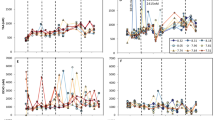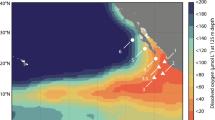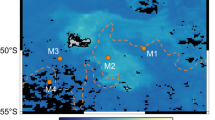Abstract
DISSOLVED organic carbon (DOC) in the deep sea is, after sedimentary humus, the largest reservoir of organic carbon in the hydrosphere. It is utilised primarily by heterotrophic bacteria, which over a long period, in steady–state conditions consume dissolved O2 from the seawater and produce an equivalent amount of CO2 by respiration. Knowledge of the rates of O2 consumption (Table 1) and CO2 production is useful for quantifying the mixing and circulation of deep-sea water through variations in its O2 or natural radiocarbon content1,2. The aim of the work reported here was to determine the growth rate of a heterotrophic, low nutrient bacterium isolated from seawater collected at a depth of 2,000 m in the north-central Pacific Ocean (25°03′N, 154°53′W), and to equate this growth rate with O2 consumption and utilisation of DOC.
This is a preview of subscription content, access via your institution
Access options
Subscribe to this journal
Receive 51 print issues and online access
$199.00 per year
only $3.90 per issue
Buy this article
- Purchase on Springer Link
- Instant access to full article PDF
Prices may be subject to local taxes which are calculated during checkout
Similar content being viewed by others
References
Munk, W. H., Deep-Sea Res., 13, 707–730 (1966).
Craig, H., J. geophys. Res., 76, 5078–5086 (1971).
Jannasch, H. W., Eimhjellen, K., Wirsen, C. O., and Farmanfarmaian, A., Science, 171, 672–675 (1971).
Sorokin, Y. I., in Proc. twentieth Nobel Symp. (edit by Dryssen, D., and Tagner, D.), (Wiley–Interscience, New York and London, 1972).
Packard, T. T., Healy, M. L., and Richards, F. Q., Limnol. Oceanogr., 16, 60–70 (1971).
Holm-Hansen, O., and Paerl, H. W., Mem. Ist. Ital. Idrobiol., 29, Suppl., 149–168 (1972).
Taga, N., and Matsuda, O., in Effect of the Ocean Environment on Microbial Activities (edit. by Colwell, R., and Morita, R.), (University Park Press, Baltimore, London and Tokyo, 1974).
Gordon, D. C., Deep-Sea Res., 18, 1127–2234 (1971).
Prelim. Data Rep. Geochemical Ocean Sections Study, Pacific Expedition, Leg I, Station 206, August–September, 1973 (Scripps Inst. Oceanogr., San Diego, 1974).
Williams, P. M., Ocschger, H., and Kinney, P. J., Nature, 224, 256–258 (1969).
Arhelger, M. E., Kinney, P. J., Linick, T. W., and Williams, P. M., Research on the Marine Food Chain, AEC Progress Report, 363–389 (University of California, San Diego, 1974).
Author information
Authors and Affiliations
Rights and permissions
About this article
Cite this article
WILLIAMS, P., CARLUCCI, A. Bacterial utilisation of organic matter in the deep sea. Nature 262, 810–811 (1976). https://doi.org/10.1038/262810a0
Received:
Accepted:
Published:
Issue Date:
DOI: https://doi.org/10.1038/262810a0
This article is cited by
-
The ProkaBioDen database, a global database of benthic prokaryotic biomasses and densities in the marine realm
Scientific Data (2022)
-
An attempt to understand the behavior of dissolved organic carbon in coastal aquifers of Pondicherry region, South India
Environmental Earth Sciences (2016)
-
Vertical distribution of the prokaryotic cell size in the Mediterranean Sea
Helgoland Marine Research (2012)
-
Photochemical degradation of dissolved organic carbon and its impact on the oceanic carbon cycle
Nature (1991)
-
Photochemical source of biological substrates in sea water: implications for carbon cycling
Nature (1989)
Comments
By submitting a comment you agree to abide by our Terms and Community Guidelines. If you find something abusive or that does not comply with our terms or guidelines please flag it as inappropriate.



